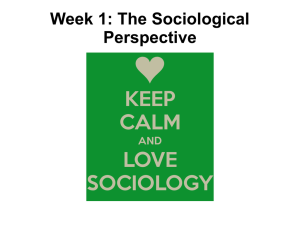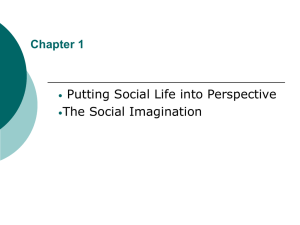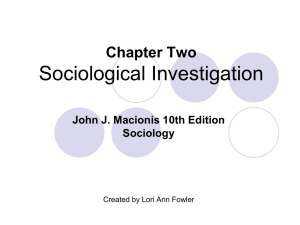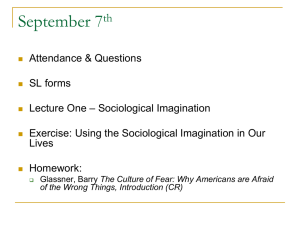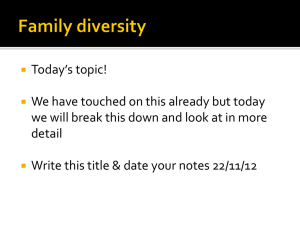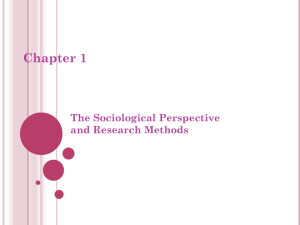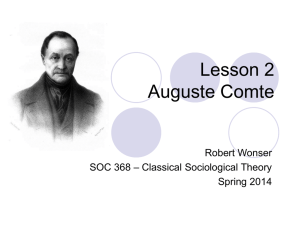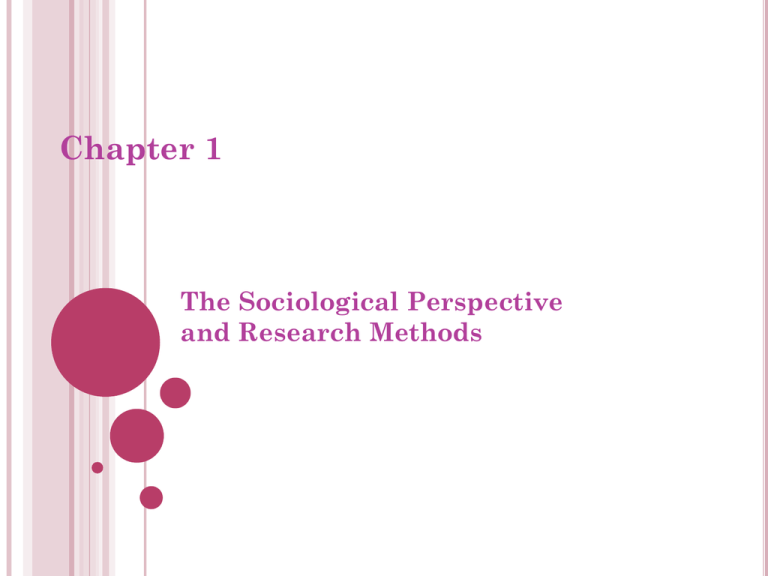
Chapter 1
The Sociological Perspective
and Research Methods
Have you ever wondered…
About the structure and organization of society?
How all the “pieces” of society fit together?
What makes society “function”? What causes it to
be “dysfunctional”?
How people are influenced by factors in their
social environment including their family, the
media as well as educational, political and
economic institutions, etc.?
Sociology Students…
Explore these questions everyday in an attempt
to understand “why people do the things they do”
within the structure of a particular society from a
sociological perspective.
Welcome to an elite group of scholars.
The “So What and Who Cares” Factor
Sociologists study what has happened, what
patterns can be observed and what social factors
may have contributed to the existing social
condition.
The discipline of Sociology also studies who cares
and who is affected by the social condition right
now.
Election 2008
What are the issues that you think sociologists
would analyze regarding the presidential race of
2008?
How do you think the following issues would be
relevant?
Race and Ethnicity
Age
Gender
Social Class
The Sociological Imagination
(1) What is the structure of this particular society
as a whole?
(2) Where does this society stand in human
history?
(3) What varieties of men and women now prevail
in this society and in this period? And what
varieties are coming to prevail?
Are We A Product of Our Environment
The sociological perspective says that we are a
product of the socialization we receive in our
culture.
Family is the primary agent of socialization in
this life long process.
Chapter Outline
Contemporary Theoretical Perspectives
The Sociological Research Process
Research Methods
Ethical Issues in Sociological Research
Putting Sociological Life into Perspective
Sociology is the systematic study of human
society and social interaction.
Sociologists study societies and social
interactions to develop theories about:
How behavior is shaped by group life
How group life is affected by individuals
Why Study Sociology?
Helps us gain a better understanding of ourselves
and our social world.
Helps us see how behavior is shaped by the
groups to which we belong and our society.
Promotes understanding and tolerance by
helping us look beyond personal experiences and
gain insight into the larger world order.
Society
A large social grouping that shares the same
geographical territory, and is subject to the same
political authority and dominant cultural
expectations.
We are all affected by global interdependence, a
relationship in which the lives of all people are
intertwined and any nation’s problems are part of
a larger global problem.
Fields That Use Social Science Research
How Much Do You Know About Suicide?
True or False?
In the United States, suicide occurs on the average of
one every 17 minutes.
How Much Do You Know About Suicide?
True.
A suicide occurs on the average of every 17 minutes in
the United States.
This differs with respect to the sex, race/ethnicity,
and age of the individual.
Men are four times more likely to kill themselves
than are women.
How Much Do You Know About Suicide?
True or False?
More teenagers and young adults die from suicide
than from cancer, heart disease, AIDS, birth defects,
stroke, pneumonia, influenza, and chronic lung
disease combined.
How Much Do You Know About Suicide?
True.
Suicide is a leading cause of death among teenagers and
young adults.
It is the third leading cause of death among young
people between 15 and 24 years of age, following
unintentional injuries and homicide.
Suicide
As a Personal Trouble:
Many people consider suicide to be the
result of personal problems.
As a Public Issue:
Sociologist Emile Durkheim related suicide to the issue
of cohesiveness in society instead of viewing it as an
isolated act that could be understood by studying
individual personalities or inherited tendencies.
Suicide Rates by Race and Sex
Importance of a Global Sociological
Imagination
The future of our nation is intertwined with the
future of other nations on economic, political,
environmental, and humanitarian levels.
Understanding diversity and developing
tolerance for people who are different from us is
important for our personal, social, and economic
well-being.
High-Income Countries
These
are nations with highly
industrialized economies; technologically
advanced industrial, administrative, and
service occupations; and high levels of
national and personal income.
Examples: United States, Canada
They generally have a have a high standard of
living and a lower death rate due to advances in
nutrition and medical technology.
Middle-Income Countries
Sometimes referred to as developing countries,
these are nations with industrializing economies,
particularly in urban areas, and moderate levels
of national and personal income.
Examples: Nations of Eastern Europe and many Latin
American countries, where nations such as Brazil and Mexico
are industrializing rapidly
.
Low-Income Countries
Low-income countries are primarily agrarian
nations with little industrialization and low
levels of national and personal income.
Examples: Many of the nations of Africa and Asia, particularly
India and the People’s Republic of China.
Race, Ethnicity, and Class
Race
is a term used to specify groups of
people distinguished by physical
characteristics.
Most sociologists consider race a social construction
used to justify inequalities.
Ethnicity refers to cultural identity and is based
on factors such as language or country of origin.
Class is based on wealth, power, prestige, or
other valued resources.
Sex and Gender
Sex refers to the biological and anatomical
differences between females and males.
Gender refers to the meanings, beliefs, and
practices associated with sex differences, referred
to as femininity and masculinity.
Industrialization
The process by which societies are transformed
from dependence on agriculture and handmade
products to dependence on manufacturing
industries.
First occurred during the Industrial Revolution
in Britain between 1760 and 1850.
Resulted in massive economic, technological, and
social changes.
People were forced to leave rural communities to
seek employment in the emerging cities.
Urbanization
The process by which an increasing proportion of
a population lives in cities rather than rural
areas.
The factory system led to a rapid increase in the
number of cities and the size of populations.
People from diverse backgrounds began working
in the same factory and living in the same
neighborhoods.
This led to the development of new social
problems: inadequate housing, crowding,
unsanitary conditions, poverty, pollution, and
crime.
August Comte
Considered the “founder of sociology.”
Comte’s philosophy became known as
positivism— a belief that the world can best be
understood through scientific inquiry.
Comte believed objective, bias-free knowledge
was attainable only through the use of science
rather than religion.
Two Dimensions of Comte’s Positivism
1.
Methodological
2.
The application of scientific knowledge to physical and
social phenomena.
Social and political
The use of such knowledge to predict the likely results of
different policies so the best one could be chosen.
Harriet Martineau
Believed society would improve when:
women and men were treated equally
enlightened reform occurred
cooperation existed among all social classes
Herbert Spencer
Contributed an evolutionary perspective on social
order and social change.
Social Darwinism
The belief that the human beings best adapted to their
environment survive and prosper, whereas those poorly
adapted die out.
Emile Durkheim
Believed the limits of human potential are
socially based.
One of his most important contributions was the
concept of social facts.
Social facts are patterned ways of acting, thinking, and feeling
that exist outside any one individual but exert social control
over each person.
Karl Marx
Viewed history as a clash between conflicting
ideas and forces.
Believed class conflict produced social change and
a better society.
Combined ideas from philosophy, history, and
social science into a new theory.
Max Weber
Believed sociological research should exclude
personal values and economic interests.
Provided insights on rationalization, bureaucracy
and religion.
Georg Simmel
Theorized about society as a web of patterned
interactions among people.
Analyzed how social interactions vary depending
on the size of the social group.
Developed formal sociology, an approach that
focuses attention on the universal recurring
social forms that underlie the varying content of
social interaction.
Jane Addams
Founded Hull House, one of the most famous
settlement houses, in Chicago.
One of the authors of a methodology text used by
sociologists for the next forty years.
Awarded Nobel Prize for assistance to the
underprivileged.
W.E.B. Du Bois
One of the first to note the identity conflict of
being both Black and American.
Pointed out that people in the U.S. espouse
values of democracy, freedom, and equality while
they accept racism and group discrimination.
Theoretical Perspectives
Theoretical perspectives are based on ideas about
how social life is organized.
The major perspectives in U.S. sociology are:
Functionalist
Conflict
Symbolic Interactionist
Postmodernist
Major Theoretical Perspectives
Theory
View of Society
Functionalist
Composed of interrelated parts
that work together to maintain
stability.
Conflict
Society is characterized by social
inequality; social life is a struggle
for scarce resources.
Major Theoretical Perspectives
Theory
View of Society
Symbolic
Interactionist
Behavior is learned in interaction
with other people.
Postmodernist
Postindustrialization, consumerism,
and global communications bring
into question assumptions about
social life and the nature of reality.
Polling Question
Which sociological perspective do you think
explains the concept of inequality in our
society the most accurately?
A.
B.
C.
D.
Structural-functionalist
Conflict
Symbolic interactionist
Feminist
The Sociological Research Process
Research is the process of systematically
collecting information for the purpose of testing
an existing theory or generating a new one.
The relationship between theory and research
has been referred to as a continuous cycle.
Theory and Research Cycle
Quantitative and Qualitative Research
Quantitative research focuses on data that can be
measured numerically.
Example: comparing rates of suicide
Qualitative research focuses on interpretive
description rather than statistics to analyze
underlying meanings and patterns of social
relationships.
Conventional Research Model
1.
2.
3.
4.
5.
6.
Select and define the research problem.
Review previous research.
Formulate the hypothesis.
Develop the research design.
Collect and analyze the data.
Draw conclusions and report the findings.
Hypothesized Relationships Between
Variables: Causal
Hypothesized Relationships Between
Variables: Inverse Causal
Hypothesized Relationships Between
Variables: Multiple Causes
Qualitative Research Method
1.
Researcher begins with a general approach
rather than a highly detailed plan.
2.
Researcher has to decide when the literature
review and theory application should take
place.
Qualitative Research Method
3.
The study presents a detailed view of the topic.
4.
Access to people or other resources that can
provide necessary data, is crucial.
5.
Appropriate research methods are important
for acquiring useful qualitative data.
Research Methods: Survey Research
Describes a population without interviewing each
individual.
Standardized questions force respondents into
categories.
Relies on self-reported information, and some
people may not be truthful.
Research Methods:
Analysis of Existing Data
Materials studied may include:
public records, official reports, and raw data collected
by other researchers
books, diaries, poems, and graffiti
movies, television shows, advertisements, greeting
cards
music, art, and even garbage
Research Methods:
Field Research
Study of social life in its natural setting.
Observing and interviewing people where they
live, work, and play.
Generates observations that are best described
verbally rather than numerically.
Approaches to Field Research
Participant observation
Collecting observations while part of the activities of
the group being studied.
Ethnography
Detailed study of the life and activities of a group of
people over a period of years.
Research Methods: Experiments
Study the impact of certain variables on subjects’
attitudes or behavior.
Designed to create “real-life” situations.
Used to demonstrate a cause-and-effect
relationship between variables.
Polling Question
If you possessed the money, skill, and other
necessary resources, in which one area would
you like to conduct research?
A.
B.
C.
D.
Racial profiling
The cause(s) of sexual orientation
Sexual assault and abuse
The effects of divorce on children
ASA Code of Ethics
1.
Disclose research findings in full and include all
possible interpretations of the data.
2.
Safeguard the participants’ right to privacy and
dignity, while protecting them from harm.
ASA Code of Ethics
3.
Protect confidential information provided by
participants.
4.
Acknowledge research collaboration and
disclose all financial support.
Quick Quiz
1. Sociology helps us get a better understanding of
ourselves and our world by:
A.
B.
C.
D.
enabling us to see how behavior is shaped by the groups to
which we belong and the society in which we live.
enabling us to see how behavior is shaped by the large
social structures that comprise society.
enabling us to see how behavior is shaped by the social
institutions and close knit friendships in which we belong.
enabling us to see how behavior is shaped by a combination
of pathological and social forces.
Answer: A
Sociology helps us get a better understanding
of ourselves and our world by enabling us to
see how behavior is shaped by the groups
to which we belong and the society in
which we live.
2. Using the Sociological Imagination allows us to:
A.
B.
C.
D.
bridge knowledge between Psychology and Sociology.
make personal troubles public issues.
make in-roads into finding absolute truth.
bridge the gap between micro and macro processes.
Answer: B
Using the Sociological Imagination allows us to
make personal troubles public issues.
3. The approach that begins with a theory and
uses research to test the theory is called:
A.
B.
C.
D.
qualitative
deductive
quantitative
inductive
Answer: B
The approach that begins with a theory and uses
research to test the theory is called deductive.
4. Durkheim identified four types of suicide. They
are:
A.
B.
C.
D.
Altruistic, Egoistic, Anomic, Fatalistic
Altruistic, Egocentric, Anomic, Fatalistic
Altruistic, Anthroscopic, Egocentric, Fatalistic
Altruistic, Egoistic, Anthroscopic, Egocentric
Answer: A
Durkheim identified four types of suicide. They
are: Altruistic, Egoistic, Anomic, Fatalistic.

